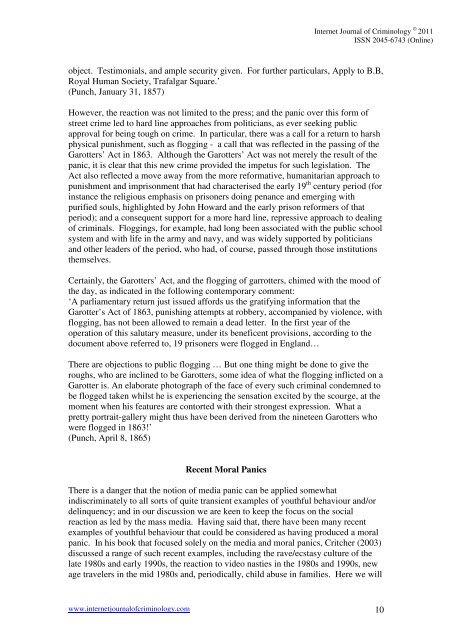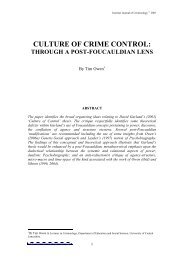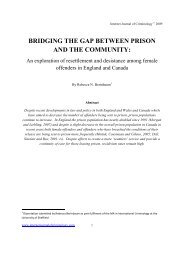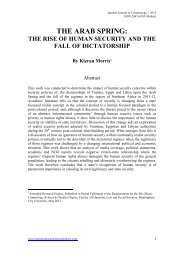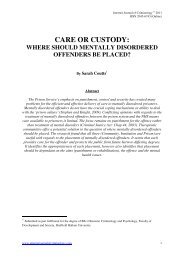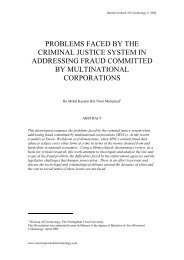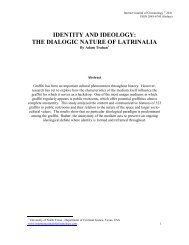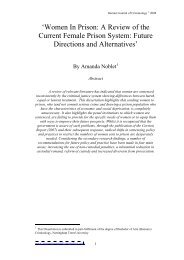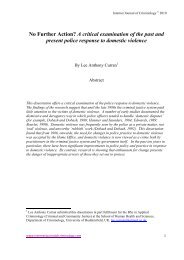moral panics and the british media - Internet Journal of Criminology
moral panics and the british media - Internet Journal of Criminology
moral panics and the british media - Internet Journal of Criminology
You also want an ePaper? Increase the reach of your titles
YUMPU automatically turns print PDFs into web optimized ePapers that Google loves.
<strong>Internet</strong> <strong>Journal</strong> <strong>of</strong> <strong>Criminology</strong> © 2011<br />
ISSN 2045-6743 (Online)<br />
object. Testimonials, <strong>and</strong> ample security given. For fur<strong>the</strong>r particulars, Apply to B.B,<br />
Royal Human Society, Trafalgar Square.’<br />
(Punch, January 31, 1857)<br />
However, <strong>the</strong> reaction was not limited to <strong>the</strong> press; <strong>and</strong> <strong>the</strong> panic over this form <strong>of</strong><br />
street crime led to hard line approaches from politicians, as ever seeking public<br />
approval for being tough on crime. In particular, <strong>the</strong>re was a call for a return to harsh<br />
physical punishment, such as flogging - a call that was reflected in <strong>the</strong> passing <strong>of</strong> <strong>the</strong><br />
Garotters’ Act in 1863. Although <strong>the</strong> Garotters’ Act was not merely <strong>the</strong> result <strong>of</strong> <strong>the</strong><br />
panic, it is clear that this new crime provided <strong>the</strong> impetus for such legislation. The<br />
Act also reflected a move away from <strong>the</strong> more reformative, humanitarian approach to<br />
punishment <strong>and</strong> imprisonment that had characterised <strong>the</strong> early 19 th century period (for<br />
instance <strong>the</strong> religious emphasis on prisoners doing penance <strong>and</strong> emerging with<br />
purified souls, highlighted by John Howard <strong>and</strong> <strong>the</strong> early prison reformers <strong>of</strong> that<br />
period); <strong>and</strong> a consequent support for a more hard line, repressive approach to dealing<br />
<strong>of</strong> criminals. Floggings, for example, had long been associated with <strong>the</strong> public school<br />
system <strong>and</strong> with life in <strong>the</strong> army <strong>and</strong> navy, <strong>and</strong> was widely supported by politicians<br />
<strong>and</strong> o<strong>the</strong>r leaders <strong>of</strong> <strong>the</strong> period, who had, <strong>of</strong> course, passed through those institutions<br />
<strong>the</strong>mselves.<br />
Certainly, <strong>the</strong> Garotters’ Act, <strong>and</strong> <strong>the</strong> flogging <strong>of</strong> garrotters, chimed with <strong>the</strong> mood <strong>of</strong><br />
<strong>the</strong> day, as indicated in <strong>the</strong> following contemporary comment:<br />
‘A parliamentary return just issued affords us <strong>the</strong> gratifying information that <strong>the</strong><br />
Garotter’s Act <strong>of</strong> 1863, punishing attempts at robbery, accompanied by violence, with<br />
flogging, has not been allowed to remain a dead letter. In <strong>the</strong> first year <strong>of</strong> <strong>the</strong><br />
operation <strong>of</strong> this salutary measure, under its beneficent provisions, according to <strong>the</strong><br />
document above referred to, 19 prisoners were flogged in Engl<strong>and</strong>…<br />
There are objections to public flogging … But one thing might be done to give <strong>the</strong><br />
roughs, who are inclined to be Garotters, some idea <strong>of</strong> what <strong>the</strong> flogging inflicted on a<br />
Garotter is. An elaborate photograph <strong>of</strong> <strong>the</strong> face <strong>of</strong> every such criminal condemned to<br />
be flogged taken whilst he is experiencing <strong>the</strong> sensation excited by <strong>the</strong> scourge, at <strong>the</strong><br />
moment when his features are contorted with <strong>the</strong>ir strongest expression. What a<br />
pretty portrait-gallery might thus have been derived from <strong>the</strong> nineteen Garotters who<br />
were flogged in 1863!’<br />
(Punch, April 8, 1865)<br />
Recent Moral Panics<br />
There is a danger that <strong>the</strong> notion <strong>of</strong> <strong>media</strong> panic can be applied somewhat<br />
indiscriminately to all sorts <strong>of</strong> quite transient examples <strong>of</strong> youthful behaviour <strong>and</strong>/or<br />
delinquency; <strong>and</strong> in our discussion we are keen to keep <strong>the</strong> focus on <strong>the</strong> social<br />
reaction as led by <strong>the</strong> mass <strong>media</strong>. Having said that, <strong>the</strong>re have been many recent<br />
examples <strong>of</strong> youthful behaviour that could be considered as having produced a <strong>moral</strong><br />
panic. In his book that focused solely on <strong>the</strong> <strong>media</strong> <strong>and</strong> <strong>moral</strong> <strong>panics</strong>, Critcher (2003)<br />
discussed a range <strong>of</strong> such recent examples, including <strong>the</strong> rave/ecstasy culture <strong>of</strong> <strong>the</strong><br />
late 1980s <strong>and</strong> early 1990s, <strong>the</strong> reaction to video nasties in <strong>the</strong> 1980s <strong>and</strong> 1990s, new<br />
age travelers in <strong>the</strong> mid 1980s <strong>and</strong>, periodically, child abuse in families. Here we will<br />
www.internetjournal<strong>of</strong>criminology.com 10


